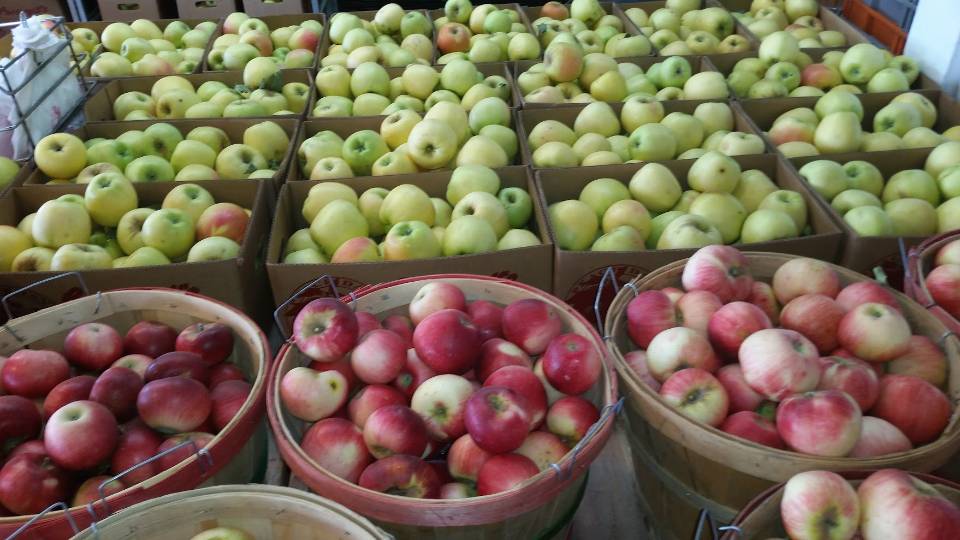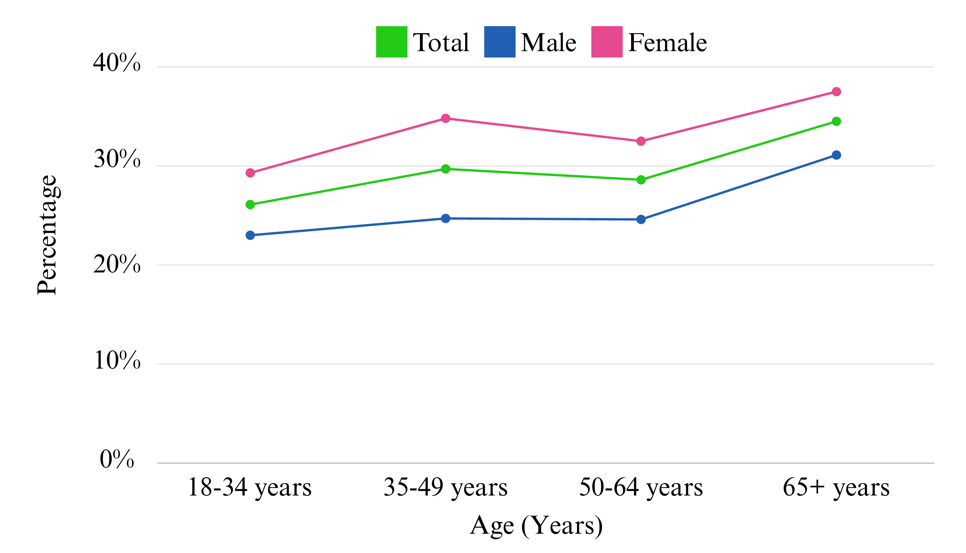Fruit Consumption Indicators:
Who Consumes More Fruit in Utah?

Introduction
While fruits are an important part of a healthy diet and provide essential nutrients, many Americans do not eat recommended levels of fruit (Harvard School of Public Health, 2018; Economic Research Service [ERS], 2023). Fruits are excellent sources of vitamins and minerals that are essential to human health. Many fruits are rich in potassium, fiber, vitamin C, and folate (Harvard School of Public Health, 2018; ERS, 2023). These micronutrients are important for maintaining healthy blood pressure, reducing cholesterol levels, promoting healthy bowel function, and growing and repairing body tissues. Additionally, research shows that diets high in fruits and vegetables are associated with a lower risk of chronic diseases like cardiovascular disease, Type 2 diabetes, and some kinds of cancer (Harvard School of Public Health, 2018). As fruits are typically low in calories, diets high in fruit are often lower in total energy intake. Evidence suggests that a diet high in fruits and vegetables can also prevent eye conditions related to aging such as cataracts and macular degeneration (Harvard School of Public Health, 2018).
Many factors influence fruit consumption:
- Demographics
- Socioeconomic status
- Household circumstances
- Access
- Personal preferences
Given all the potential health benefits of consuming fresh produce, especially fruits, why are Americans not eating enough fruit? Previous studies show that many factors influence fruit consumption, including demographics, socioeconomic status, household circumstances, access, and personal preferences (Emanuel et al., 2012; Guthrie et al., 2005; Liese et al., 2013; Middaugh et al., 2012; Prattala et al., 2006). This fact sheet discusses fruit consumption patterns in Utah, exploring the key demographic and socioeconomic factors linked to increased fruit intake. Fruit growers and marketers can use this information to design effective promotional campaigns targeting consumers more likely to purchase fruit and fruit products.
Determinants of Fruit Consumption
Data from the Behavior Risk Factor Surveillance System (BRFSS) in 2021 found that 29% to 34% of adults in Utah eat fruit twice a day or more (Public Health Indicator Based Information System [IBIS], 2022). Research has shown that differences in fruit consumption are seen across age, gender, income, and education levels (Emanuel et al., 2012; Guthrie et al., 2005; Liese et al., 2013; Middaugh et al., 2012; Prattala et al., 2006). Additional factors that impact fruit consumption include household size and the presence of children in the household, as well as access to grocery stores and other retail food stores (Guthrie et al., 2005; Liese et al., 2013).
Age

When fruit consumption was assessed by age among Utahns, BRFSS data show the highest fruit consumption among individuals over age 65 (seniors), as 34.5% of this age group consumes fruit at least twice daily (IBIS, 2022). In contrast, only 26.1% of those aged 18 to 34 years in Utah consumed fruit at least twice daily. Fruit consumption appears to plateau in middle age. The higher proportion of fruit intake by those over 65 years of age may be due to more time available for meal preparation during retirement or greater interest in maintaining health due to the health concerns associated with aging (Guthrie et al., 2005).
Across all age groups in Utah, women tend to eat more fruit than men (IBIS, 2022) (see Figure 1). For each age group, 6%–10% more women than men in Utah reported eating fruit at least twice daily. This gender disparity in fruit consumption has been frequently observed by researchers in other states (Emanuel et al., 2012; Prattala et al., 2006). Research overall suggests that women tend to consume more fruit than men, possibly due to their historical focus on the health benefits of fresh produce, as well as greater self-efficacy or confidence in preparing and enjoying fresh produce (Emanuel et al., 2012; Prattala et al., 2006).

Race and Ethnicity
BRFSS data from Utah did not include information on fruit consumption by race or ethnicity, and the U.S. Census Bureau reports that Utah’s population is 76.7% non-Hispanic white (United States Census Bureau, n.d.; IBIS, 2022). Research from areas outside of Utah indicates that culture plays a major role in dietary choice (Guthrie et al., 2005). The “Mediterranean diet” has often been lauded for its ability to reduce blood pressure and promote heart health, and both Asian and Hispanic cuisines have been noted to include a wider variety of vegetables than the typical American diet (American Heart Association [AHA], 2020; Guthrie et al., 2005).
Income

Education
One consistently strong correlation with fresh produce consumption is education level (Guthrie et al., 2005; Liese et al., 2013; Middaugh et al., 2012). In 2005, U.S. Department of Agriculture (USDA) research by the Economic Research Service (ERS) found that among all income levels, education had a greater impact on fruit and vegetable consumption than income (Guthrie et al., 2005). After adjusting for income, the study found that households with a college education demonstrated the highest per capita spending on produce (Guthrie et al., 2005). Utah shows a similar pattern, as the highest fruit consumption was among college graduates, with 38.3% of those with an advanced education consuming fruit at least twice daily (IBIS, 2022) (see Figure 3). In contrast, only 27.4% of those with a high school diploma or GED consumed fruit at least twice daily.
According to the USDA ERS, the improved diet quality observed in individuals with higher education levels may stem from a greater knowledge of the importance of maintaining a healthy diet and the benefits of consuming fruits and vegetables (Guthrie et al., 2005). Another study suggests that the connection between education and increased fruit and vegetable intake could be attributed to a greater understanding of nutrition. However, it also acknowledges that advanced education is often correlated with higher income and stronger social support from friends and family (Middaugh et al., 2012).

Household Size
Besides providing support, families can influence the selection of fruits and vegetables (Guthrie et al., 2005). In their study, Guthrie et al. (2005) also discovered differences in vegetable consumption based on household size. Four-person households consumed the greatest variety of produce (16–24 types of vegetables), while single-person households consumed the fewest vegetable varieties (10 types). Moreover, variety began to decline once households grew beyond four persons, with households of five or more people consuming 14 types of vegetables (Guthrie et al., 2005). This pattern likely extends to the variety of fruits purchased by a household. The research team proposed that the decreased variety consumed by larger households may be due to the difficulty of pleasing multiple people when planning and preparing meals. Furthermore, they noted that children have a negative impact on the variety of fresh produce purchased and consumed in a household. Children may veto vegetables or fruits they dislike, thereby influencing parents to repeatedly purchase “approved” foods instead of selecting a variety of produce.
Fresh Produce Access
Access to grocery stores and other food retailers also influences fresh produce consumption. BRFSS data for Utah was divided by health district but did not include information on access to grocery stores (IBIS, 2022). A study by Liese et al. (2013) conducted a statistical analysis of environmental factors related to fruit and vegetable intake. Researchers looked at the distance to supermarkets from participants’ homes, the availability of healthy foods at local stores, and how frequently study participants shopped at their primary grocery stores. They found that frequently shopping at one primary store was the only factor that independently and statistically significantly influenced fresh produce consumption. Researchers also found that supermarket availability (distance traveled) was significantly associated with shopping frequency. When study participants had to travel farther to reach a supermarket, they shopped for groceries less frequently, which then led to a diet lower in fresh produce (Liese et al., 2013).
Conclusions
While fresh produce consumption has many health benefits, Americans do not consume recommended levels. In Utah, only 34% of adults eat fruit at least twice daily. Fruit consumption varies across age, gender, income, household characteristics, and education levels. In Utah, those more likely to consume higher amounts of fruit include women and seniors above age 65. Additionally, those with high incomes and higher levels of education consume the most fruit. Moreover, households consisting of four persons with few or no children as well as those with greater access to grocery stores are also likely to consume more fruits.
References
- American Heart Association (AHA). (2020, January 9). Mediterranean diet. American Heart Association. https://www.heart.org/en/healthy-living/healthy-eating/eat-smart/nutrition-basics/mediterranean-diet
- Economic Research Service (ERS). (2023, February 13). Organic agriculture. U.S. Department of Agriculture. https://www.ers.usda.gov/topics/natural-resources-environment/organic-agriculture/
- Emanuel, A. S., McCully, S. N., Gallagher, K. M., & Updegraff, J. A. (2012). Theory of Planned Behavior explains gender difference in fruit and vegetable consumption. Appetite, 59(3), 693–697. https://doi.org/10.1016/j.appet.2012.08.007
- Guthrie, J., Lin, B.-H., Reed, J., & Stewart, H. (2005, April 1). Understanding economic and behavioral influences on fruit and vegetable choices. Economic Research Service, U.S. Department of Agriculture. https://www.ers.usda.gov/amber-waves/2005/april/understanding-economic-and-behavioralinfluences-on-fruit-and-vegetable-choices/
- Harvard School of Public Health. (2018, August 20). Vegetables and fruits. The Nutrition Source, Harvard T.H. Chan School of Public Health. https://www.hsph.harvard.edu/nutritionsource/what-should-youeat/vegetables-and-fruits/
- Liese, A. D., Bell, B. A., Barnes, T. L., Colabianchi, N., Hibbert, J. D., Blake, C. E., & Freedman, D. A. (2013). Environmental influences on fruit and vegetable intake: Results from a path analytic model. Public Health Nutrition, 17(11), 2595–2604. https://doi.org/10.1017/s1368980013002930
- Middaugh, A. L., Fisk, P. S., Brunt, A., & Rhee, Y. S. (2012). Few associations between income and fruit and vegetable consumption. Journal of Nutrition Education and Behavior, 44(3), 196–203. https://doi.org/10.1016/j.jneb.2011.10.003
- Prattala, R., Paalanen, L., Grinberga, D., Helasoja, V., Kasmel, A., & Petkeviciene, J. (2006). Gender differences in the consumption of meat, fruit and vegetables are similar in Finland and the Baltic countries. The European Journal of Public Health, 17(5), 520–525. https://doi.org/10.1093/eurpub/ckl265
- Public Health Indicator Based Information System (IBIS). (2022, December 20). Complete health indicator report of daily fruit consumption. Utah Department of Health & Human Services. https://ibis.health.utah.gov/ibisph-view/indicator/complete_profile/5aDayFruit.html
- United States Census Bureau. (n.d.). U.S. Census Bureau QuickFacts: Utah. January 12, 2024, from https://www.census.gov/quickfacts/fact/table/UT/PST045223
July 2024
Utah State University Extension
Peer-reviewed fact sheet
Authors
Makaylie Langford, USU Extension Intern, Department of Applied Economics
Kynda Curtis, Professor and USU Extension Specialist, Department of Applied Economics
Related Research


